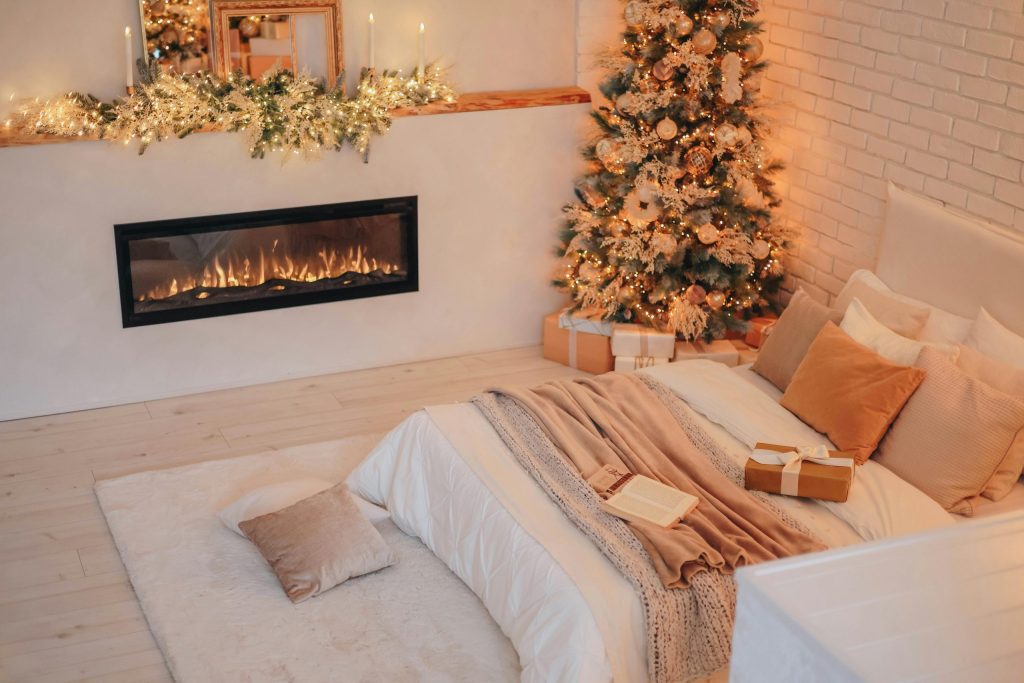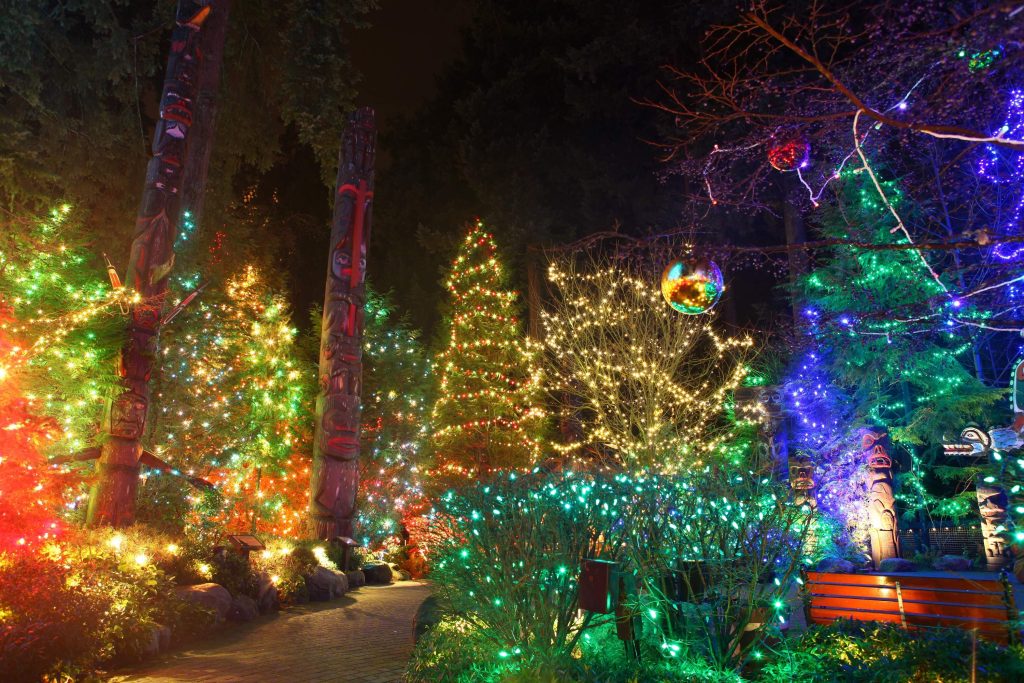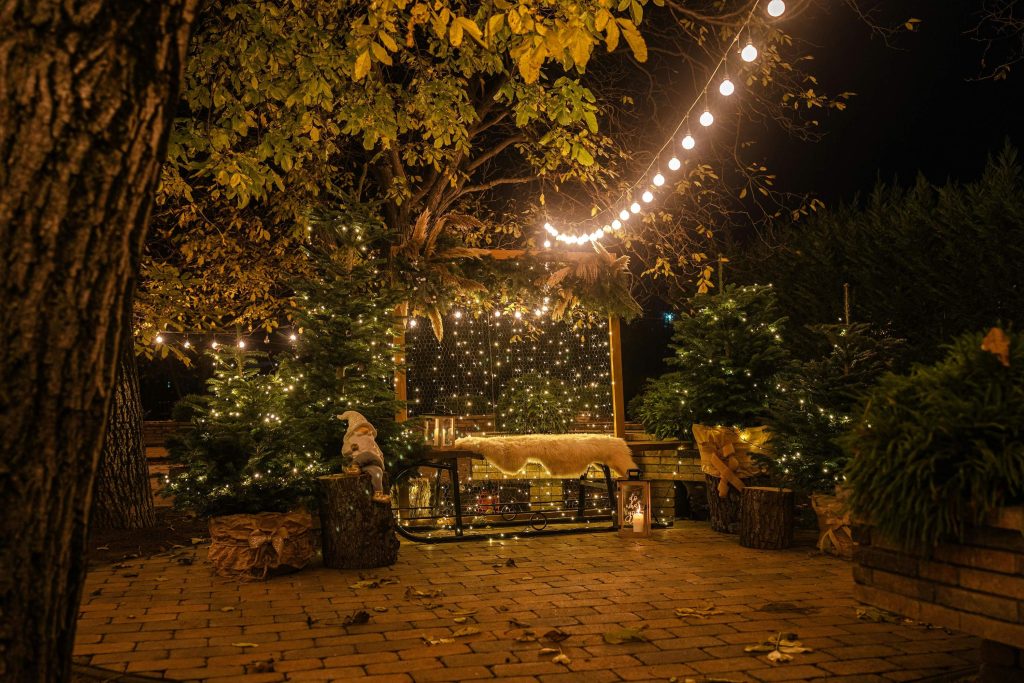A Complete Safety Guide to Sleeping with String Lights On
The Enchanting Allure of String Lights
Lately, there has been a remarkable increase in the popularity of string lights within home decor trends. Revered for their ability to evoke a sense of warmth, whimsy, and romantic charm, they have become an integral part of interior and exterior designs worldwide. Not merely confined to festive occasions such as Christmas or Diwali, they’re now often used year-round to enhance spaces with their enchanting glow.
From bedrooms draped in ethereal soft light for a cozy ambiance to backyards illuminated by landscape string lights that transform them into magical alfresco spaces, the application spectrum seems boundless. These glowing emblems are ambassadors of conviviality, capable of turning ordinary settings into aesthetically pleasing landscapes that seem trapped in perpetual twilight.
String lights, or fairy lights, as they are sometimes affectionately known, can be seen adorning terraces and balconies, casting a spell over garden landscapes, or creating an intimate atmosphere at social gatherings. Landscape lighting using string lights not only enhances visual appeal but also adds depth and character to outdoor spaces.
Unveiling the Topic: Is It Safe to Sleep with String Lights On?
While there is no denying the charismatic allure that these tiny luminaries bring with them, it is imperative to delve beyond mere aesthetics and address critical safety considerations. Are we compromising our safety for beauty? More explicitly put, is it safe to sleep with string lights on?
The question may appear trivial at first glance but becomes significant when we consider that many people often leave these twinkling companions on overnight, be it for comfort during slumber or simply for maintaining a dreamlike ambiance throughout nocturnal hours. As we embark on this explorative journey together, let’s unravel this topic inch by inch by dissecting various aspects surrounding the safety measures involved when using string lights during sleep hours.

While we relish the inviting glow and the captivating milieu these lights create, it becomes our responsibility to ensure that this decorative feature doesn’t become a safety hazard. Thus, in this comprehensive assessment, we will explore the potential risks and precautions related to using string lights overnight.
Through a meticulous exploration of expert opinions, case studies, and safety guidelines, we aim at providing an in-depth understanding of how one can safely enjoy the mesmerizing allure of string lights without being oblivious to their potential hazards. So let’s delve into this illuminating conundrum – Is it indeed safe to sleep with string lights on?
Unraveling the Enigma of String Lights
A terminological discussion about string lights is warranted before we delve into the exploration of their safety in nocturnal settings. String lights, also known as fairy lights or twinkle lights, are diminutive yet radiant sources of light that are strung together by a common electrical wire.
This charming arrangement has these luminous pearls nestled close to each other, dutifully radiating a soft glow that makes them irresistible in both indoor and outdoor settings. The appeal of string lights lies not only in their aesthetic charm and versatility but also in their uncanny ability to transform commonplace areas into mesmerizing spectacles.
From draping over bed canopies to adorning patio edges, these miniature lanterns infuse spaces with an enchanting warmth and welcoming aura. They can alter a mundane backdrop into a fairy tale scene with just one inconspicuous flick of a switch.
The Multifaceted Types of String Lights
In our contemporary era where choice is abundant, there is no exception when it comes to the types of string lights available in the market. LED string lights are perhaps the most popular variant owing to their energy efficiency and longevity. Emitting light from tiny diodes rather than a filament or discharge tube as with traditional bulbs, these LED versions offer commendable durability while consuming less energy.
Incandescent string lights offer an alternative choice for those seeking an authentic vintage feel. These utilize thin wire filaments heated until they glow, exuding a warm luminescence akin to candlelight that many find comforting and familiar.
For outdoor enthusiasts seeking landscape lighting solutions, solar-powered and battery-operated versions have come to bear significant importance. Landscape string lights harnessing solar power capitalize on daylight absorption for nocturnal lighting, thereby offering an eco-friendly lighting solution devoid of additional electricity costs.
Battery-operated variants, on the other hand, provide convenience and portability, allowing for creativity even in the absence of a nearby power source. These are ideal for temporary installations like parties or camping, where they transform spaces with their ethereal glow independent of any electrical reliance.
Common Usage: The Alluring Night-Time Glow
In recent times, string lights have begun to transcend their traditional usage in festive decor and are increasingly being incorporated into everyday interior design. Their delightful twinkling allure creates an intimate atmosphere that is as comfortable as it is captivating.
Many individuals prefer leaving string lights on overnight as a gentle sleep aid, fostering a soothing ambiance to lull them into slumber. For others, it is simply the charm these lights exude that makes them an irresistible nocturnal companion.
Exterior landscape lighting also sees these shimmering companions left on overnight. Landscape string lights create an entrancing spectacle, illuminating pathways or accentuating garden features. They serve the dual purpose of enhancing aesthetic appeal whilst providing practical visibility in darkness, thereby contributing significantly to outdoor safety.
Conclusively speaking, the predilection for keeping string lights on throughout the night emerges from both aesthetic and pragmatic reasoning. As we go through our presentation, we intend to unravel whether this practice aligns with safety norms or ventures into potentially hazardous territory.
The Safety Aspect of Landscape Lighting: Understanding the Risks
Although the ethereal glow from landscape string lights on a tranquil night may seem innocuous, it is vital to understand the safety concerns tied to their usage overnight. Like any other electrical appliance, these lights carry inherent risks. A general rule of thumb is that every electrical device must be used judiciously, adhering strictly to safety precautions and guidelines provided by manufacturers.
The safety considerations related to string lights can be multifaceted. They encompass fire hazards, risk of electric shocks, and potential health impacts due to overexposure. The need for caution escalates when these appliances are left on unattended for extended periods, especially while we sleep.
Fire Risk Associated with String Lights
A significant concern is the fire hazard posed by overheating or faulty wiring in string lights that are left switched on overnight. Overheating can occur if bulbs become excessively hot – a common problem with older incandescent models or low-quality LED variants.

Faulty wiring can also lead to sparks that could ignite nearby inflammable materials. When specifically talking about landscape string lights, leaving them on continuously may increase the risk, as they often come into close proximity with outdoor elements like trees and plants that can easily catch fire if a bulb overheats or a spark occurs due to an electrical fault.
It’s crucial, therefore, not only to purchase high-quality landscape lighting but also to ensure they are installed correctly with safe distances maintained from potential combustible materials. Regular inspection of wiring and bulbs in landscape lighting setups is another important preventive measure against this hazard.
Potential for Electrical Shocks
The second major risk associated with using string lights continuously throughout the night involves electrical shocks due to improper handling or usage scenarios where moisture might be involved – an important consideration for outdoor landscape lighting setups that are exposed to weather elements. Improper handling could involve touching the bulbs while they are switched on or trying to adjust the string lights without turning them off first.
In an outdoor setting, weather conditions like rain might lead to moisture seeping into socket areas or along with the wiring of landscape lighting. If left unattended, this could create a dangerous situation where people could receive electrical shocks if they come into contact with these dampened lights.
Again, it’s vital to use only high-quality and suitable landscape lighting designed for outdoor usage that incorporates appropriate safety features such as waterproof sockets and insulation on wiring. Regular inspections for any wear and tear followed by immediate repair or replacement of damaged components is also key in mitigating this risk.
Health Risks Linked with Overnight Lighting
Health risks associated with leaving string lights on during sleep hours cannot be overlooked. The presence of artificial light during sleep can lead to a disruption in our body’s natural circadian rhythms – the internal process that regulates our sleep-wake cycle, which repeats roughly every 24 hours.
Exposure to light during bedtime can affect melatonin production – a hormone that influences sleep. This can result in disturbed sleep patterns leading to poor quality rest and associated health issues such as fatigue, decreased cognitive function, or mood disorders over time.
Further, prolonged exposure to bright lights at night may also cause eye strain, especially when your eyes transition from a brightly lit environment outdoors due to landscape lighting into total darkness indoors at bedtime. Prudent use of landscape lighting entails ensuring that while it enhances the aesthetic appeal of your surroundings overnight, it does not compromise your safety or well-being.
Factors Influencing Safety
Quality and Design: The Foundation of Safe String Lights
The safety of sleeping with string lights on starts at the very root – the quality and design of the string lights themselves. Cheaply made, low-quality products are more likely to present risks such as overheating or short-circuiting. Poorly designed products may also have thin wiring or substandard connections that can fray or break, escalating potential hazards.
In contrast, high-quality string lights are constructed with robust materials meant to withstand prolonged usage. When it comes to landscape string lights often used for outdoor decoration, they must also be durable enough to endure various weather conditions without compromising their structure or functionality.
The design should incorporate safety features like fuse-protected plugs, which can prevent power surges from causing damage. Furthermore, LED-based string lights are a better choice over incandescent bulbs due to their lower heat emission and higher energy efficiency. A well-made LED light will have an effective heat sink that dissipates heat away from the bulb, reducing fire risk.
The longevity of your landscape lighting is highly dependent on its quality and design. Poorly constructed lighting systems may not only pose potential safety hazards but also require frequent replacement due to shorter lifespans. Therefore, investing in superior quality and intelligently designed string lights ensures not just aesthetic appeal but also promotes nighttime safety in your living spaces – both indoors and outdoors.
Proper Installation: Reducing Risks through Correct Usage
Irrespective of the superior quality or design of your chosen light system, improper installation could jeopardize its safety implications. This is particularly relevant while setting up intricate arrangements such as landscape lighting, where attention to detail is paramount for both aesthetic function and overall security.
Ensure that all connections are secure and that the lights are hung or positioned in a manner that doesn’t strain the wires or create tripping hazards.
String lights should never be affixed using nails or tacks, as these can pierce the wire insulation and lead to electrical shorts. Instead, use insulated hooks or clips specifically designed for hanging string lights.
When utilizing landscape string lights, they should not be installed near pools, fountains, or other bodies of water unless they are rated for such use. Also, avoid entangling any cords under rugs or close to flammable items such as curtains and paper decorations.
For indoor use, do not run cords across doorways since this can cause wear and tear on the wirings over time due to frequent foot traffic. It’s also recommended to unplug your string lights when not in use to prevent overheating.
In essence, proper installation is integral in maintaining safety standards of string light usage. A meticulous approach mitigates potential risks associable with their application both outdoors and indoors.
Maintenance: Ensuring Safety through Regular Checks
A crucial element often overlooked is regular maintenance of your lighting system. String lights may appear harmless; however, regular checks for any signs of wear or damage can significantly reduce any risk involved.
Although LED bulbs have an impressive lifespan compared to incandescent ones, it’s still important to periodically check whether all bulbs function correctly and replace them promptly if they don’t. Inoperable bulbs could indicate underlying problems such as faulty wiring, which could potentially lead to fire hazards.

Frequent scrutiny is particularly essential when you employ outdoor landscape lighting exposed continuously to various weather elements, which may degrade their integrity over time. Cords should be regularly examined for fraying or other signs of wear.
Unplugging before carrying out inspections provides a safe environment to scrutinize for any potential issues. Remember, even the best quality lights will eventually wear out and require replacement.
Conclusively, regular maintenance of your string lights is a proactive measure to ensure their safety. It allows for timely detection of potential problems and subsequent rectification, thus promoting safer use during sleep times.
Safe Practices When Using String Lights Overnight: A Path to Safe Lighting
When it comes to string lights, safety should always be the priority. Opting for LED lights over incandescent ones is a prudent choice. LED lights are highly energy-efficient and emit significantly less heat than their incandescent counterparts. This reduced thermal output curtails the risk of overheating, which is a common cause of fire hazards linked to string lighting.
Reliable installation forms the backbone of safe usage. String lights should be installed away from flammable materials such as curtains, wooden furniture, or paper decorations to prevent potential fire incidents. Landscape string lights, in particular, should avoid direct contact with bushes or trees that might catch fire due to excessive heat production.
Regular maintenance and checks cannot be overemphasized. Over time, daily wear and tear can lead to fraying or cracking of wires, which may pose electrical risks or instigate fire incidents. It is essential, therefore, to frequently inspect your string lights for any signs of damage.
A timer ensures limited usage during sleep hours, providing an extra layer of safety and economy without compromising on aesthetics or comfort. It systematically switches off the light operation after a predetermined period, reducing risks while you are in deep slumber.
Understanding String Lights Safety: Expert Opinions and Studies
Expert electricians often emphasize the need for vigilance when using string lights on a long-term basis – landscape lighting being no exception. They propose timely replacement at regular intervals even if there are no visible signs of damage due to the possibility of internal wear and tear, which may not be evident externally but could prove hazardous.
Scientific studies have also shed light on how exposure to artificial lighting during sleep can disrupt our circadian rhythm – our body’s natural sleep-wake cycle – leading potentially to sleep disorders and health issues over time.
Exploring Alternatives to Leaving String Lights On Overnight: Safe Nights with Subtle Lights
Nightlights or dim lamps could serve as viable alternatives to string lights. They provide sufficient lighting without posing the risks associated with leaving string lights on throughout the night. Their soft glow can create a soothing ambiance conducive to sleep.
Sleep technology offers another intriguing alternative. Sound machines emitting gentle noise or smart bulbs that adjust brightness levels based on time can also ensure a comfortable and safe sleep environment.
Conclusion: Is It Safe to Sleep with String Lights On?
String lights, particularly landscape string lights, offer aesthetic appeal, but their continuous use during sleep hours requires certain safety measures to be put in place. Besides opting for LEDs and ensuring proper installation away from flammable materials, regular checks for signs of damage are paramount. Timer usage provides an additional layer of safety while experts reinforce the need for vigilance during long-term use.
Alternatives such as dim lamps or modern sleep tech tools could be considered to mitigate risks while maintaining a serene nighttime ambiance. An informed decision driven by safety considerations will allow you to enjoy the soft glow of string lights without compromising peace of mind and well-being.
You may also be interested in the following posts:
